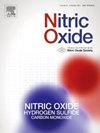Targeting inducible nitric oxide synthase with 1400W mitigates septic acute lung injury through inhibiting SLC7A11/GPX4 mediated ferroptosis
IF 3.2
2区 生物学
Q2 BIOCHEMISTRY & MOLECULAR BIOLOGY
引用次数: 0
Abstract
Accumulating evidence has indicated that lung ferroptosis is an important contributor to septic acute lung injury (SALI). Inducible nitric oxide synthase (iNOS) may be implicated in the regulation of bronchial epithelial ferroptosis. Nevertheless, the precise mechanisms by which iNOS modulates ferroptosis remain elusive. This study investigated whether iNOS selective inhibitor 1400w alleviates LPS-induced SALI and suppresses ferroptosis in mice. Additionally, RNA sequencing (RNA-seq), molecular docking, molecular dynamic simulation, Transmission electron microscope (TEM), and western blotting were employed to predict and evaluate the molecular mechanism of 1400w on LPS-induced ferroptosis in vivo. The results showed that the administration of 1400w markedly attenuated LPS-induced lung injury and facilitated pulmonary function in mice. Also, 1400w administration effectively suppressed bronchial epithelial ferroptosis induced by LPS in mice. Furthermore, molecular docking and molecular dynamics simulations revealed stable binding between GPX4 and iNOS, with 1400w modulating ferroptosis mediated by SLC7A11/GPX4 through targeting iNOS. Collectively, our research demonstrated that inhibition of iNOS might represent a potential therapeutic strategy to improve SALI by inhibiting ferroptosis.
1400W靶向诱导型一氧化氮合酶,通过抑制SLC7A11/GPX4介导的铁凋亡减轻脓毒性急性肺损伤
越来越多的证据表明,肺铁下垂是脓毒性急性肺损伤(SALI)的重要因素。诱导型一氧化氮合酶(iNOS)可能参与支气管上皮铁下垂的调节。然而,iNOS调节铁下垂的确切机制仍然难以捉摸。本研究探讨iNOS选择性抑制剂1400w是否能减轻lps诱导的小鼠SALI并抑制铁下垂。采用RNA测序(RNA-seq)、分子对接、分子动力学模拟、透射电镜(TEM)、western blotting等方法预测和评价1400w对lps诱导铁下垂的分子机制。结果表明,1400w可明显减轻lps诱导的小鼠肺损伤,促进肺功能。1400w给药可有效抑制LPS诱导的小鼠支气管上皮铁下垂。此外,分子对接和分子动力学模拟揭示了GPX4与iNOS之间的稳定结合,SLC7A11/GPX4通过靶向iNOS介导1400w调制铁死亡。总的来说,我们的研究表明,抑制iNOS可能是一种通过抑制铁下垂来改善SALI的潜在治疗策略。
本文章由计算机程序翻译,如有差异,请以英文原文为准。
求助全文
约1分钟内获得全文
求助全文
来源期刊

Nitric oxide : biology and chemistry
生物-生化与分子生物学
CiteScore
7.50
自引率
7.70%
发文量
74
审稿时长
52 days
期刊介绍:
Nitric Oxide includes original research, methodology papers and reviews relating to nitric oxide and other gasotransmitters such as hydrogen sulfide and carbon monoxide. Special emphasis is placed on the biological chemistry, physiology, pharmacology, enzymology and pathological significance of these molecules in human health and disease. The journal also accepts manuscripts relating to plant and microbial studies involving these molecules.
 求助内容:
求助内容: 应助结果提醒方式:
应助结果提醒方式:


